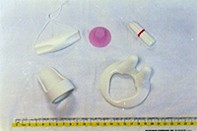Peer Reviewed
Feature Article Women’s health
Female urinary stress incontinence: what causes it and how to treat it
Abstract
Stress incontinence is the most common form of female urinary incontinence and may be caused by urethral hypermobility or intrinsic sphincter deficiency. The many conservative and surgical therapies that are available need to be tailored to meet each woman’s needs.
Key Points
- Urinary stress incontinence is the most common cause of urinary incontinence and is experienced by 20% of adult women, resulting in a significant reduction in quality of life.
- Half of all women suffering from urinary stress incontinence will not tell their general practitioner they have this problem.
- Aetiology is multifactorial but possible risk factors include age, obesity, constipation, parity, childbirth, smoking, connective tissue abnormalities and denervation of the pelvic floor. Hysterectomy and menopause are not risk factors.
- Pelvic floor exercises can significantly improve stress incontinence symptoms.
- Women should be offered treatment when they have to alter their lifestyle to minimise their stress incontinence.
- There are many conservative and surgical therapies available, which should be tailored to meet the individual’s needs; pelvic floor exercises and the Burch colposuspension are two of the most widely used.
Purchase the PDF version of this article
Already a subscriber? Login here.

